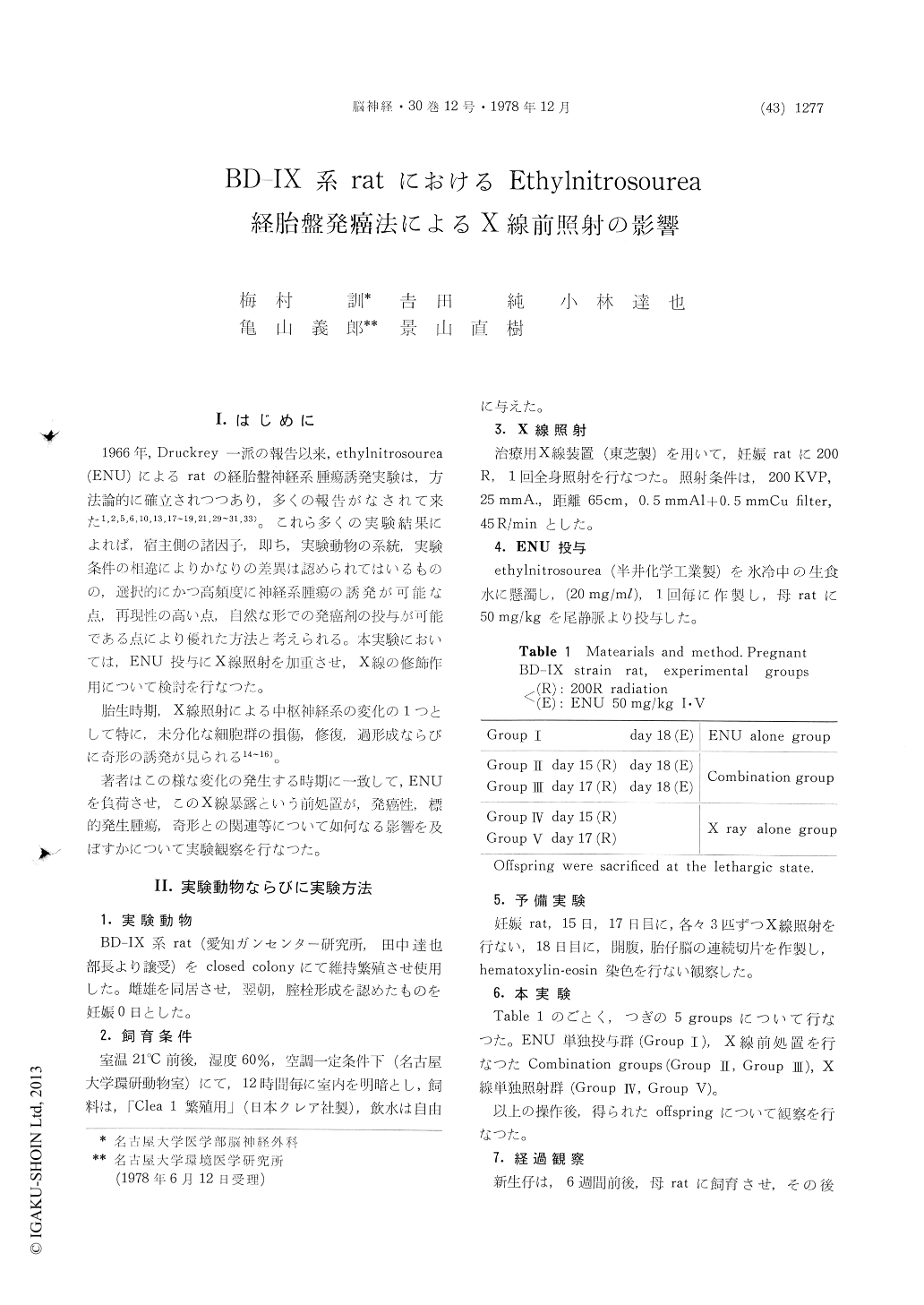Japanese
English
- 有料閲覧
- Abstract 文献概要
- 1ページ目 Look Inside
Ⅰ.はじめに
1966年,Druckrey一派の報告以来,ethylnitrosourea(ENU)によるratの経胎盤神経系腫瘍誘発実験は,方法論的に確立されつつあり,多くの報告がなされて来た1,2,5,6,10,13,17〜19,21,29〜31,33)。これら多くの実験結果によれば,宿主側の諸因子,即ち,実験動物の系統,実験条件の相違によりかなりの差異は認められてはいるものの,選択的にかつ高頻度に神経系腫瘍の誘発が可能な点,可現性の高い点,自然な形での発癌剤の投与が可能である点により優れた方法と考えられる。本実験においては,ENU投与にX線照射を加重させ,X線の修飾作用について検討を行なつた。
胎生時期,X線照射による中枢神経系の変化の1つとして特に,未分化な細胞群の損傷,修復,過形成ならびに奇形の誘発が見られる14〜16)。
Transplacental treatment of ethylnitrosourea induced tumors selectively to the nervous system of rats. The aim of this study was the effects of X-ray in this transplacental carcinogenesis.
Animals (BD-IX rats) were divided into 5 groups. Single dose of 50mg/kg ENU was injected intra-venously to the pregnant rats at the 18th day of gestation (Group I). Pregnant rats of Group II, III, IV and V were at first irradiated 200 rads at the 15th day (Group II and IV) and the 17th day of gestation (Group III and V), and Group II and III were followed by ENU intravenous injection at the 18th day same as Group I. Group IV and V were only X-ray treatment.
Comparing the results of 5 groups, the litter size and growth rate of rats were markedly reduced by double treatments.
And also, the tumor incidence was definitely decreased, which was 97. 1% in Group I, 62.5% in Group II, and 57.1% in Group III respectively. The latency period for tumor formation was 185±33 days (Mean±S. D.) in Group I, 220±25 days in Group II, and 234.5±55 days in Group III. About the tumor location in various experimental groups, intracerebral tumors were found in 23/85 (27%) of Group I, 0/23 of Group II, and 3/12 (25%) of Group III. Spinal cord tumor were 15/85 in Group I, 3/23 in Group II, while peripheral nervous tumors (trigeminal nerve tumor, spinal root tumor and others) were 45/85 in Group I, 20/25 in Group II, and 6/12 in Group III.
Histologically, the remarkable finding was the reduced incidence of glial tumors in the double treatment groups. It was 36/85(45%) in ENU alone group, while it was 9/35 (26%) in combination groups. The incidence of neurinoma was 53% in Group I, 87% in Group II, and 50% in Group III. Especially, the most remarkable difference by double treatments was reduction of intracerebral tumor, which was 23/85 in Group I, while it was disap-peared in Group II. Double treatments decreased the incidence of ependymoblastoma and increased that of "undifferentiated"neurinoma.
Congenital malformations of the central nervous system (dysgenic hydrocephalus and microcephalus) were associated with tumor in most animals of Group II and Group III. These malformations were also found in X-ray alone groups. But the degree and incidence of malformation was higher and more in combination groups than X-ray alone groups.
It was suspected that the X-ray irradiation in these series had influence mainly on the matrix layer of cerebrum rather than on the spinal cord and the peripheral nervous system for tumor formation.

Copyright © 1978, Igaku-Shoin Ltd. All rights reserved.


